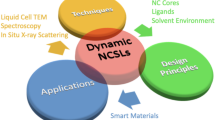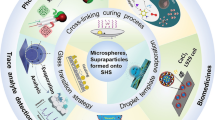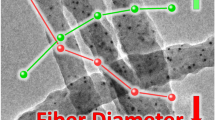Abstract
We report the use of surface-initiated polymerization (SIP) to facilitate nanolithography-based template-directed synthesis of various 3D freestanding nanostructures (sub-10 nm) with arbitrary 3D anisotropic shapes and different compositions on the nano/molecular scale in a designated way. In particular, SIP is combined with “top-down” nanolithographic techniques, such as electron-beam lithography, to fabricate nanotemplates with 3D recessed nanosites that possess both reduced feature size and anisotropic surface functionalities. Implementation of SIP can address the technical challenge for nanolithography to directly produce molecular-scale feature sizes, since the scale gap between what nanolithography can achieve and molecular feature sizes can be bridged, both in terms of size as well as chemical functionality, by the SIP-induced polymer layer. More significantly it enables a nanotemplate with tunable surface chemistry, leading to appropriate registration of nano-objects onto the template for molding as well as effective de-molding, resulting in 3D conformal freestanding synthetic nanostructures. In this work both 0-D polystyrene colloidal nanoparticles (NPs) and polystyrene–iron(III) oxide composites NPs are properly assembled and molded by the templates resulting in different nanostructures with desirable shapes and functionalities. The demonstrated 3D freestanding nanostructures (sub-10 nm) include “nanomushrooms,” “nanobuttons,” “nanospikes,” “nanospaghetti,” and “nanoflowers”. In addition, the resultant PS–Fe3O4 composite nanostructures and their assemblies show ferromagnetic properties. Although the template-based surface synthesis produces low quantities compared to a traditional “bottom-up” chemical synthesis method, the templates allow for specific design of shapes and chemical functionalities of NPs to be directly designed, which may be advantageous in many applications such as drug delivery or imaging.









Similar content being viewed by others
References
Bang J, Jeong U, Ryu DY, Russell TP, Hawker CJ (2009) Block copolymer nanolithography: translation of molecular level control to nanoscale patterns. Adv Mater 21:4769–4792
Barbey R, Lavanant L, Paripovic D, Schuuwer N, Sugnaux C, Tugulu S, Klok H (2009) Polymer brushes via surface-initiated controlled radical polymerization: synthesis, characterization, properties, and applications. Chem Rev 109:5437–5527
Bwana NN (2007) Use of photoresist templates in the synthesis of highly-order arrays of titania nanorods. J Nanopart Res 9:1139–1143
Craighead HG (2000) Nanoelectromechanical systems. Science 290:1532–1535
Duguet E, Desert A, Perro A, Ravaine S (2011) Design and elaboration of colloidal molecules: an overview. Chem Soc Rev 40:941–960
Engel M, Small JP, Steiner M, Freitag M, Green AA, Hersam MC, Avourist P (2008) Thin film nanotube transistors based on self-assembled, aligned, semiconducting carbon nanotube arrays. ACS Nano 2:2445–2452
Fennimore AM, Yuzvinsky TD, Han WQ, Fuhrer MS, Cumings J, Zettl A (2003) Rotational actuators based on carbon nanotubes. Nature 424:408–410
Ge J, Hu Y, Biasini M, Dong C, Beyermann WP, Yin Y (2007) One-step synthesis of highly water-soluble magnetite colloidal nanocrystals. Chem Eur J 13:7153–7161
Jeon N, Choi I, Whitesides G, Kim N, Laibinis P, Harada Y, Finnie K, Girolami G, Nuzzo R (1999) Patterned polymer growth on silicon surfaces using microcontact printing and surface-initiated polymerization. Appl Phys Lett 75:4201–4203
Jeong U, Wang Y, Ibisate M, Xia Y (2005) Some new developments in the synthesis, functionalization, and utilization of monodisperse colloidal spheres. Adv Funct Mater 15:1907–1921
Joachim C, Gimzewski JK, Aviram A (2000) Electronics using hybrid-molecular and mono-molecular devices. Nature 408:541–548
Juillerat F, Solak HH, Bowen P, Hofmann H (2005) Fabrication of large-area ordered arrays of nanoparticles on patterned substrate. Nanotechnology 16:1311–1316
Kim SO, Solak HH, Stoykovich MP, Ferrier NJ, de Pablo JJ, Nealey PF (2003) Epitaxial self-assembly of block copolymers on lithographically defined nanopatterned substrates. Nature 424:411–414
Kinkhabwala A, Yu Z, Fan S, Avlasevich Y, Mullen K, Moerner W (2009) Large single-molecular fluorescence enhancements produced by a bowtie nanoantenna. Nat Photonics 3:654–657
Krupke R, Hennrich F, Weber HB, Kappes MM, von Lohneysen H (2003) Simultaneous deposition of metallic bundles of single-walled carbon nanotubes using AC-dielectrophoresis. Nano Lett 3:1019–1023
Li S, Liu N, Chan-Park MB, Yan Y, Zhang Q (2007) Aligned single-walled carbon nanotube patterns with nanoscale width, micron-scale length and controlled pitch. Nanotechnology 18:455302
Ling XY, Phang IY, Schönherr H, Reinhoudt DN, Vancso GJ, Huskens J (2009) Freestanding 3D supramolecular particle bridges: fabrication and mechanical behavior. Small 5:1428–1435
Liu Z, Bucknall DG, Allen MG (2009) Fabrication of molecular-scale patterns with chemically tunable functionalities. In: International IEEE conference on solid-state sensors, actuators and microsystems. Transducers 2009, June 2009, pp 449–452
Liu Z, Naik N, Bucknall DG, Allen MG (2010) Mechanosynthesis of three-dimensional replicated nanostructures by nanolithography-based molecular manipulation. In: IEEE 23rd International conference on micro electro mechanical systems (MEMS), Jan 2010, pp 452–455
Liu Z, Herrault F, Kim SH, Bucknall DG, Allen MA (2011, June) Fabrication of 3-D hybrid polymer-magnetite nanostructures with geometric shape anisotropy. In: 16th International conference on solid-state sensors, actuators and microsystems, Transducers, June 2011, pp 1630–1633
Matsuura N, Rowlands JA (2008) Towards new functional nanostructures for medical imaging. Med Phys 35:4474–4487
Moulder JF, Stickle WF, Sobol PE, Bomben KE (1992) Handbook of X-ray photoelectron spectroscopy. Perkin-Elmer Corp, Eden Prairie, pp 43–44
Mullen TJ, Srinivasan C, Shuster MJ, Horn MW, Andrews AM, Weiss PS (2008) J Nanopart Res 10:1231–1240
Park SM, Liang X, Harteneck BD, Pick TE, Hiroshiba N, Wu Y, Helms BA, Olynick DL (2011) Sub-10 nm nanofabrication via nanoimprint directed self-assembly of block copolymers. ACS Nano 5:8523–8531
Rastogi A, Paik MY, Tanaka M, Ober CK (2010) Direct patterning of intrinsically electron beam sensitive polymer brushes. ACS Nano 4:771–780
Schmelmer U, Jordan R, Geyer W, Eck W, Golzhauser A, Grunze M, Ulman A (2003) Surface-initiated polymerization on self-assembled monolayers: amplification of patterns on the micrometer and nanometer scale. Angew Chem Int Ed 42:559–563
Sharma R, Strano MS (2009) Centerline placement and alignment of anisotropic nanotubes in high aspect ratio cylindrical droplets of nanometer diameter. Adv Mater 21:60–65
von Werne T, Germack D, Hagberg E, Sheares V, Hawker C, Carter KJ (2003) A versatile method for tuning the chemistry and size of nanoscopic features by living free radical polymerization. J Am Chem Soc 125:3831–3838
Wang Y, Maspoch D, Zou S, Schatz GC, Smalley RE, Mirkin CA (2006) Controlling the shape, orientation, and linkage of carbon nanotube features with nano affinity templates. PNAS 103:2026–2031
Xia DY, Brueck SRJ (2004) A facile approach to directed assembly of patterns of nanoparticles using interference lithography and spin coating. Nano Lett 4:1295–1299
Zaumseil J, Meitl MA, Hsu JWP, Acharya BR, Baldwin KW, Loo YL, Rogers JA (2003) Three-dimensional and multilayer nanostructures formed by nanotransfer printing. Nano Lett 3:1223–1227
Acknowledgments
The authors would like to thank Dr. S.-H. Kim for concept discussion, Dr. F. Herrault for the technical support on magnetic materials, Dr. N. Naik for the help on thermal oxidation process, and Mr. R. Kincer for the technical assistance on chemical reactions.
Author information
Authors and Affiliations
Corresponding author
Rights and permissions
About this article
Cite this article
Liu, Z., Bucknall, D.G. & Allen, M.G. The use of surface-initiated polymerization to reduce template feature size and facilitate fabrication of 3D freestanding nanostructures. J Nanopart Res 15, 1843 (2013). https://doi.org/10.1007/s11051-013-1843-7
Received:
Accepted:
Published:
DOI: https://doi.org/10.1007/s11051-013-1843-7




